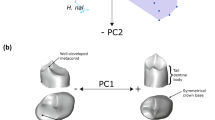Abstract
The early hominid dental remains from the Omo succession represent a fragmentary but important source of information regarding hominid evolution during the 2 to 3 myr time period. As an initial step toward the evaluation of taxonomic affinities and evolutionary significance, the present study attempts serial allocations of 21 isolated mandibular molars from the Shungura and Usno Formations. A comparative sample consisting of 250 mandibular molars ofA.afarensis, A.africanus, A.robustus, A.boisei and earlyHomo was used to compile the baseline data for allocating the isolated Omo molars to serial positions. The methods employed in the present study include morphometric analyses of 5 cusp areas, 8 linear variables reflecting crown shape, and 4 measurements of fissure pattern. It was found that by combining morphological observations with both “restricted” and “non-restricted” applications of discriminant function analyses (sensu Albrecht, 1992), sufficiently reliable serial allocations could be attained.
Similar content being viewed by others
References
Albrecht G.H., 1992. Assessing the affinities of fossils using canonical variates and generalized distances.Human Evol., 7: 49–69.
Brain C.K., 1981.The hunters or the hunted? The University of Chicago Press, Chicago.
Bromage T.G., Schrenk F. & Zonneveld F.W., 1995. Paleoanthropology of the Malawi Rift: an early hominid mandible from the Chiwondo Beds, northern Malawi.J. Hum. Evol., 28: 71–108.
Coppens Y., 1980. The differences betweenAustralopithecus andHomo; preliminary conclusions from the Omo research expedition’s studies. In (L.K. Konigsson ed.).Current argument on early man, pp. 207–225. Pergamon Press, New York.
Day M.H., Leakey R.E.F., Walker A.C. & Wood B.A., 1976. New hominids from East Turkana, Kenya.Am. J. Phys. Anthropol., 45: 369–436.
Grine F.E., 1989. New hominid fossils from the Swartkrans Formation (1979–1986 excavations): craniodental specimens.Am. J. Phys. Anthropol., 79: 409–449.
Hill A., Ward S., Deino A., Curtis G. & Drake R., 1992. The earliestHomo, Nature, 355: 719–722.
Howell F.C., 1978. Hominidae. In (V.J. Maglio & H.B.S. Cooke eds.)Evolution of African mammals, pp. 154–248. Harvard Univ. Press, Cambridge.
Howell F.C. & Coppens Y., 1976. An overview of Hominidae from the Omo succession, Ethiopia. In (Y. Coppens, F.C. Howell, G.L. Isaac & R.E.F. Leakey, eds.)Earliest man and environments in the Lake Rudolf basin, pp. 522–532. Univ. of Chicago Press, Chicago.
Howell F.C., Haesaerts P. & de Heinzelin J., 1987. Depositional environments, archeological occurrences and hominids from Members E and F of the Shungura Formation (Omo basin, Ethiopia).J. Hum. Evol., 16: 665–700.
Hunt K. & Vitzthum V.J., 1986. Dental metric assessment of the Omo fossils: implications for the phylogenetic position ofAustralopithecus africanus.Am. J. Phys. Anthropol., 71: 141–155.
Johanson D.C., White T.D. & Coppens Y., 1982. Dental remains from the Hadar Formation, Ethiopia: 1974–1977 collections.Am. J. Phys. Anthropol., 57: 545–603.
Leakey R.E.F. & Walker A.C., 1988. NewAustralopithecus boisei specimens from east and west Lake Turkana, Kenya.Am. J. Phys. Anthropol., 76:1–24.
Ramirez-Rozzi F.V., 1993. Tooth development in East AfricanParanthropus.J. Hum. Evol., 24: 429–454.
Robinson J.T., 1956. The dentition of the Australopithecinae.Transvaal Museum Mem.No. 9. Transvaal Museum, Pretoria.
Suwa G., 1988. Evolution of the “robust” australopithecines in the Omo succession: evidence from mandibular premolar morphology. In (F.E. Grine ed.)Evolutionary history of the “robust” australopithecines, pp. 199–222. Aldine de Gruyter, New York.
Suwa G., 1990.A comparative analysis of hominid dental remains from the Shungura and Usno Formations, Omo valley, Ethiopia. University Microfilms, Ann Arbor.
Suwa G., 1991. A phylogenetic analysis of Pliocene Hominidae based on premolar morphology. In (A. Ehara et al. eds.)Primatology today, pp. 509–512. Elsevier, Amsterdam.
Suwa G., Wood B.A. & White T.D., 1994. Further analysis of mandibular molar crown and cusp areas in Pliocene and Pleistocene hominids.Am. J. Phys. Anthropol., 93: 407–426.
Suwa G., White T. & Howell F.C., 1996. The mandibular postcanine dentition from the Shungura Formation, Ethiopia: crown morphology, taxonomic allocations and Plio/Pleistocene hominid evolution. Am. J. Phys. Anthropol. 101:247–282.
Tobias P.V., 1991.Olduvai Gorge, Volume 4. The skulls, endocasts and teeth of Homo habilis. Cambridge Univ. Press, Cambridge.
White T.D., 1996. African omnivores: Plio-Pleistocene hominids, suids, and global climatic changes, pp. 369–384. In (E. Vrba ed.)Paleoclimate and evolution with emphasis on human origins. Yale Univ. Press, New Haven.
Wood B., 1991.Koobi Fora research project. Volume 4. Hominid cranial remains. Clarendon Press, Oxford.
Wood B., Wood C. & Konigsberg L., 1994.Paranthropus boisei: an example of evolutionary stasis?Am. J. Phys. Anthropol., 95: 117–136.
Author information
Authors and Affiliations
Rights and permissions
About this article
Cite this article
Suwa, G. Serial allocations of isolated mandibular molars of unknown taxonomic affinities from the Shungura and Unso Formations, Ethiopia, a combined method approach. Hum. Evol. 11, 269–282 (1996). https://doi.org/10.1007/BF02436630
Received:
Accepted:
Issue Date:
DOI: https://doi.org/10.1007/BF02436630




